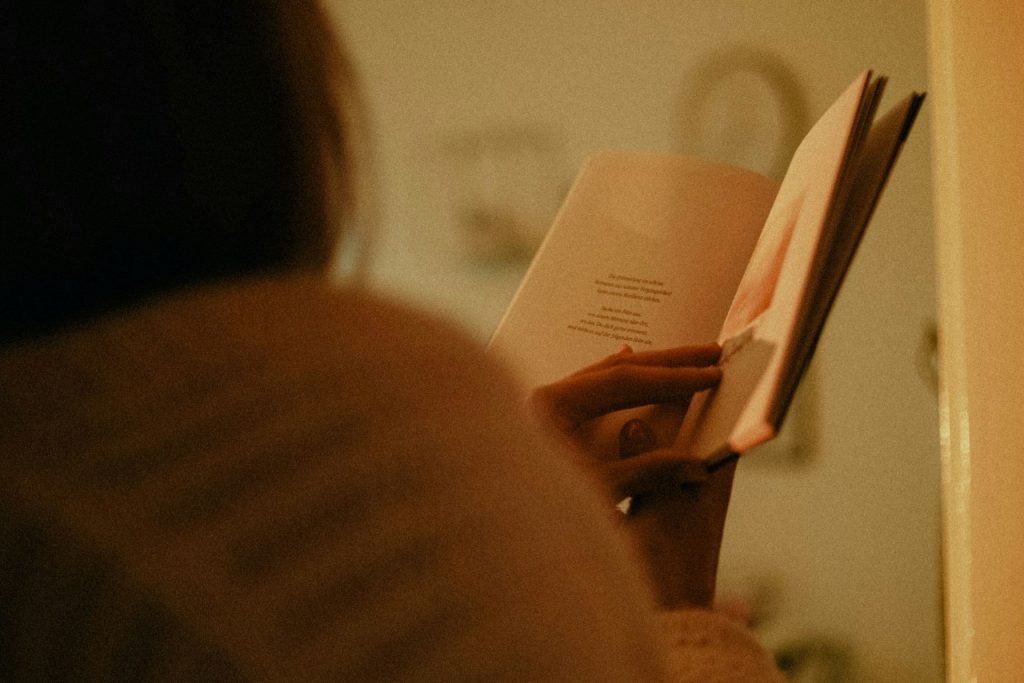There was a time when my mind didn’t know how to rest. I would crawl into bed only to be ambushed by racing thoughts, looping to-do lists, or echoes of conversations from the day. I longed for rest, but I didn’t know how to let go.
If that sounds familiar to you, I want to tell you this: you’re not alone. And there is a gentler way to wind down your day—one that doesn’t just help you fall asleep faster, but also helps you release the emotional and mental clutter you’ve unknowingly carried.
What I’ll share here isn’t a miracle cure. It’s simply the evening routine I’ve crafted through years of experimenting, reading, journaling, and learning how to slow down. It’s gentle, mindful, and deeply healing.
Let’s walk through it together.

1. The Power of the Soft Finish
Most of us are used to the hard finish: jumping off the last email, turning off the TV mid-episode, or scrolling on our phones until we fall asleep mid-thumb flick. But that approach tells our bodies nothing about the transition we’re meant to enter: rest.
What I discovered is the power of the soft finish.
For me, that starts around 8:30 PM.
At that time, I stop anything that feels stimulating—work emails, phone notifications, loud music, or intense conversations. I gently cue my body that we’re shifting into slow mode. Sometimes that means dimming the lights. Other times, it’s changing into soft, comfortable clothes. I might light a candle or turn on a diffuser with lavender essential oil.
These sensory cues help my brain register: We’re done for the day. It’s safe to relax now.
Try this: Choose one or two rituals that tell your body, “We’re winding down.” It can be as simple as brushing your hair slowly, lighting a candle, or switching to warm lighting.
2. Digital Sunset: No Screens After 9.30
This was hard to implement at first—but it’s made a massive difference.
I now treat 9.30 PM as a digital curfew. No phones. No emails. No social media rabbit holes. The blue light from screens delays melatonin release (the sleep hormone), and the constant stream of content keeps our minds active even when our bodies are tired.
Instead, I shift to offline joys: reading a physical book, stretching, or journaling.
If I need to play music or a meditation, I set it up in advance and put the phone on airplane mode.
Try this: For a week, set a “digital sunset” for yourself—at least 30 minutes before bed. Replace screen time with a calming activity: reading, drawing, or even just listening to soft music in the dark.
3. Gratitude Journaling: Clear the Mental Clutter
Before bed, I take out a notebook and write down:
-
Three things I’m grateful for
-
One moment I want to remember
-
Anything I want to release from the day
This tiny act is like a mental shower—it clears away the emotional dust that would otherwise stick to me overnight.
One night, I wrote:
“I forgive myself for being distracted during the meeting. I did my best, and tomorrow is a new chance.”
That simple sentence helped me exhale. I didn’t carry it into my dreams. I let it go on paper.
Gratitude journaling not only improves sleep quality but also rewires your brain to notice what’s working rather than fixating on what’s not.
Try this: Keep a small notebook beside your bed. Write down what went well, what you’re grateful for, and what you’re ready to let go of.

4. Herbal Tea + Hydration Ritual
I used to skip drinking anything before bed to avoid waking up in the middle of the night. But I found that sipping a small cup of warm herbal tea—chamomile, lemon balm, or a nighttime blend—brings my body into a calm, soothed state.
I pair this with one glass of room-temperature water with a pinch of sea salt or a slice of cucumber. It helps keep me hydrated without overwhelming my bladder.
The warmth of the tea is more than physical—it’s emotional. It feels like a hug for the nervous system.
Try this: Experiment with different herbal blends. Avoid caffeine after 3 PM. Sip slowly. Let this moment be about nourishment, not just hydration.
5. Gentle Movement or Yin Yoga
When I was training hard for triathlons, I often skipped nighttime movement thinking I’d already done enough. But I learned that stretching or practicing Yin Yoga at night has a different purpose—it’s not about performance, it’s about release.
Just 10-15 minutes of slow movement or even lying with my legs up the wall helps reduce cortisol (stress hormone), calm my parasympathetic nervous system, and prepare me for rest.
Some nights I lie on my mat, breathe into my hips, and tell myself:
“It’s safe to rest. You don’t have to hold anything now.”
Try this: Look up a short Yin Yoga or nighttime stretch routine. Even 5 minutes in child’s pose with deep breathing can work wonders.
6. Guided Meditation or Body Scan
I end most nights with a short guided meditation or body scan. Apps like Insight Timer, Calm, or YouTube have thousands of options.
Sometimes, I use my own voice, repeating a soft mantra:
“I did my best today. I am at peace. I am safe to let go.”
Other times, I simply breathe. In for four. Hold for four. Out for six.
This moment is sacred. It’s where I meet myself. No distractions. No performance. Just presence.
Try this: Try a 10-minute body scan or loving-kindness meditation before bed. Or record your own calming affirmations and listen to them nightly.
7. The Sleep Sanctuary Setup
Creating a peaceful sleep environment has been game-changing. Here’s what helps me:
-
A cool room (around 20°C or 68°F)
-
Blackout curtains or an eye mask
-
A white noise machine or soft rain sounds
-
Clean, soft sheets and a cozy blanket
-
No work-related items in the room
This physical space matters. When your bedroom is associated with stress, your body won’t feel safe to relax.
If your mind feels too busy, try placing a notebook by your bed to “brain dump” any thoughts before sleep.
Try this: Take 10 minutes to clear clutter from your sleeping area. Add one cozy or calming item: a pillow spray, soft lighting, or a new blanket.
What Changed for Me
Once I embraced this gentle evening routine, my sleep changed—and so did my days.
I no longer wake up feeling wired or overwhelmed. I fall asleep with ease, and wake up more refreshed. But more importantly, I feel more peaceful inside. The act of letting go each night taught me a lesson I didn’t expect:
Letting go is a muscle. The more you practice it, the stronger it becomes.
And this muscle doesn’t just help with sleep. It helps when facing uncertainty, criticism, or stress. It helps me move through life with more softness, less force.
Make It Yours
You don’t need to follow every step I shared here. Maybe your evening routine is five minutes. Maybe it’s fifty.
The key is to find what helps you transition from doing to being, from thinking to resting, from holding on to letting go.
So tonight, ask yourself:
-
What am I holding onto that I can set down?
-
What would a peaceful ending to today look like?
Then try one small act of kindness toward yourself.
Light a candle. Breathe. Forgive. Let go.
And sleep well, my friend. You deserve it.
Evening Routine Recap – A Quick Checklist
Here’s a simple cheat sheet you can bookmark or save:
8:30 PM – Soft Finish: Dim the lights, wear something cozy, set the tone
9.30:00 PM – Digital Sunset: No screens, no notifications
Gratitude Journaling: Reflect and release
Herbal Tea Ritual: Sip something soothing
Gentle Movement: Stretch, Yin Yoga, or legs up the wall
Guided Meditation: Calm the mind
Sleep Sanctuary: Cool, dark, quiet, clutter-free

